When it comes to finding a feature tree for your garden, we really are spoiled in Australia with wonderful options. There are a few important considerations that will help you to narrow down the selection and make the right choice.
In our feature tree guide, we’ve chosen 15 of our favourites that have earned themselves great popularity in gardens all over the country.
More...
What to Consider When Choosing Feature Trees for Your Garden

Firstly, you need to think about the purpose of your feature tree in the garden. Are you looking for height, or shade, or perhaps just a tree with great visual impact? Another consideration is size, both in terms of what your garden allows, and what the feature tree will require as it grows.
If you have a smaller garden, you might want to choose a tree that has height but maintains a narrow shape. The position where you plant your tree will most likely need a generous amount of sun and well-draining soil is often a must.
You need to consider whether the tree has invasive roots and whether you want an evergreen or deciduous tree. Incorporating your tree into an existing garden will also mean considering the surrounding plants and what visual effect the addition of a particular tree will have to the entire look and feel of your landscape.
Once you’ve thought about all the essentials, you can indulge your imagination and think about what kind of flowers and leaves would bring you joy, whether you want a soft or structural shape, and anything else that inspires you.
15 Best Features Trees in Australia
Queensland Bottle Tree (Brachychiton rupestris)
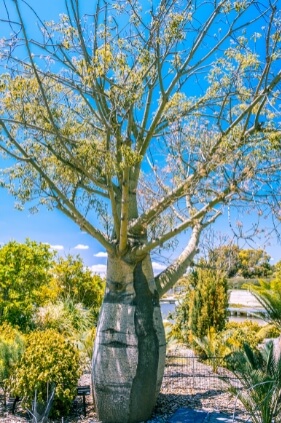
- Maximum size: The tree can grow between 10 to 20 metres tall and between 5 to 12 metres wide.
- Deciduous or evergreen: Deciduous
- Best features: The tree has a giant trunk which can grow to a diameter of up to 4 metres. It makes an interesting choice to add to a landscape with its grey bark, yellow and pink flowers, and glossy leaves.
- Best place to plant: The Queensland Bottle Tree will be happiest growing in full sun and needs space to spread out as it grows. Make sure that the tree is not shaded by other trees or buildings. This is especially important in the early growing years.
- Queensland Bottle Tree Growing Guide
Grass Tree (Xanthorrhoea glauca)
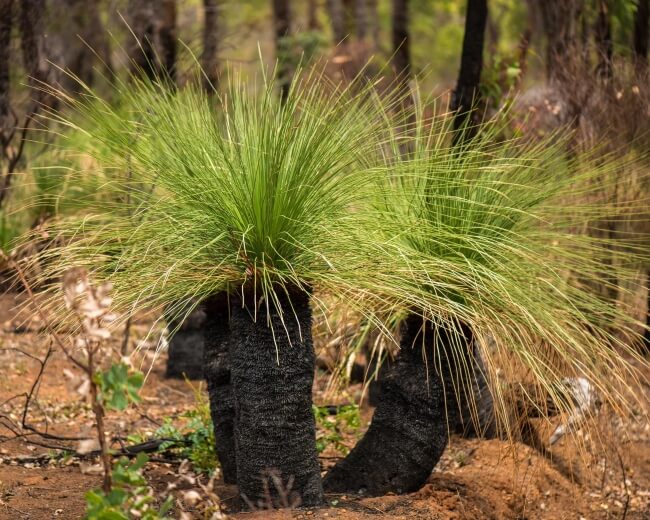
Source: Brisbane Plant Nursery
- Maximum size: It can reach a height of up to 6 metres and a spread up to 2.5 metres.
- Deciduous or evergreen: Semi-deciduous
- Best features: The Glauca Grass Tree has leaves that are a blue grey colour which makes it stand out, with stems that seem moss covered and then at the top of the stem is a clump of long and narrow leaves that look like grass. It stands out and looks quite structural.
- Best place to plant: The tree needs a sunny spot and soil with good aeration
- Xanthorrhoea Growing Guide
Tree Aloe (Aloidendron barberae)

Source: Bamboo South Coast
- Maximum size: The tree can grow up to 20 metres in height and a maximum spread of 3 metres.
- Deciduous or evergreen: Evergreen
- Best features: Tree Aloes are architectural with a branching crown of long and arching leaves that are evergreen.
- Best place to plant: The tree grows happily in any type of well-draining soil and needs to grow in a sunny spot.
Cercis canadensis ‘Forest Pansy’
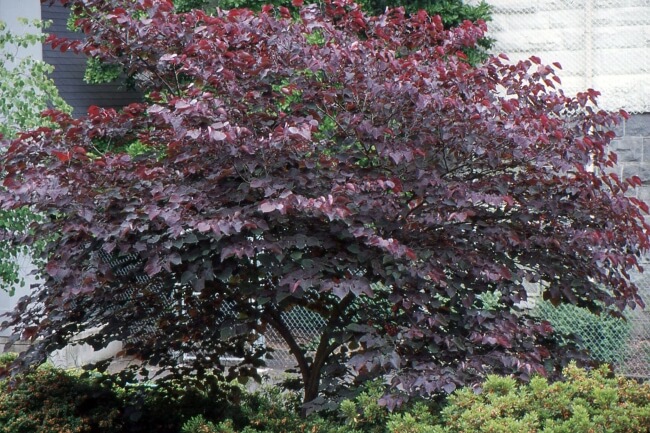
Source: Oregon State Landscape Plants
- Maximum size: Up to 8 metres in height and a spread of 10 metres.
- Deciduous or evergreen: Deciduous
- Best features: The leaves are shaped like hearts and the flowers full of nectar. In winter the branches look silver, and then in spring you have purple to pink flowers, followed by autumn leaves that are red to yellow. The flowers and buds are edible.
- Best place to plant: Forest Pansy trees will grow well in full sun or part shade underneath other trees or shaded by a home. It can also be grown in a pot.
- Cercis canadensis ‘Forest Pansy’ Growing Guide
Crepe Myrtle (Lagerstroemia indica)

- Maximum size: Up to 6 metres in height and width.
- Deciduous or evergreen: Deciduous
- Best features: This tree can either have one or multiple trunks. They produce lovely autumn leaves and bright flowers in summer that can be white, pink, red, or purple.
- Best place to plant: The Crepe Myrtle tree likes plenty of sun, ideally between 6 to 8 hours of direct sunlight daily. If they don’t get enough sun, they won’t produce as many flowers.
- Crepe Myrtle Growing Guide


Get Your Free Guide:
Master Growing Australian Natives eBook
A Must Have Complete Guide for Every Australian Garden
Get Your Free Guide:
Master Growing Australian Natives eBook
A Must Have Complete Guide for Every Australian Garden
Olive Tree (Olea europaea)
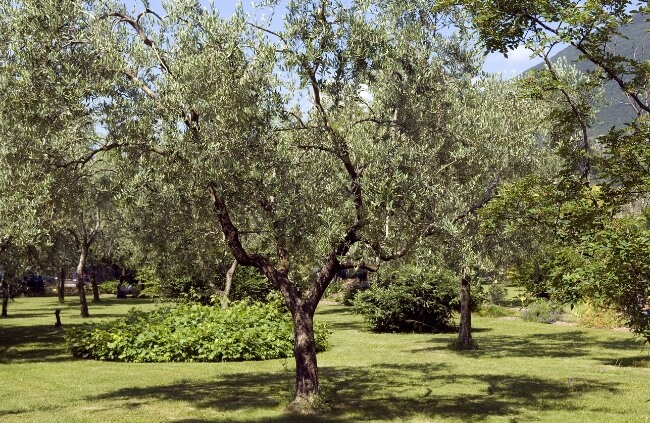
- Maximum size: Between 6 and 15 metres tall and wide.
- Deciduous or evergreen: Evergreen
- Best features: The Olive Tree has a twisted trunk and leaves that glisten and look silver. In warmer weather, the tree will give off an aroma of ripe olives.
- Best place to plant: This tree will need full sun which means 6 to 8 hours of direct sunlight each day. This includes winter.
- Olive Tree Growing Guide
Japanese Maple (Acer palmatum)
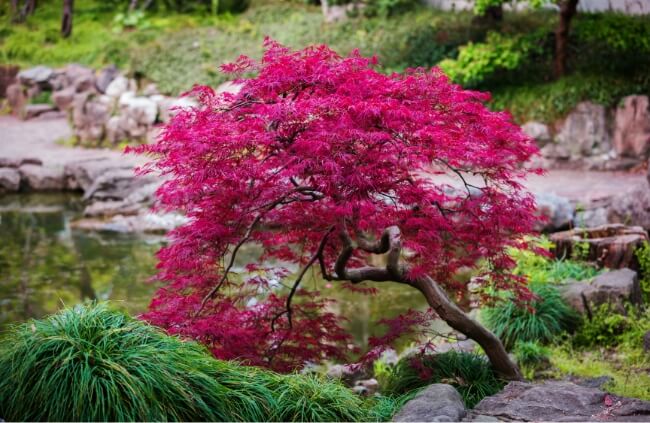
- Maximum size: The tree can grow between 4 to 8 metres in height and spread.
- Deciduous or evergreen: Deciduous
- Best features: The Japanese Maple has beautiful autumn leaves in a variety of colours that include red, yellow, purple, orange and green.
- Best place to plant: This is a slow growing tree that can be used in a pot or small garden. It would also work well on a patio, or to create borders or pathways.
- Japanese Maple Growing Guide
Irish Strawberry Tree (Arbutus unedo)
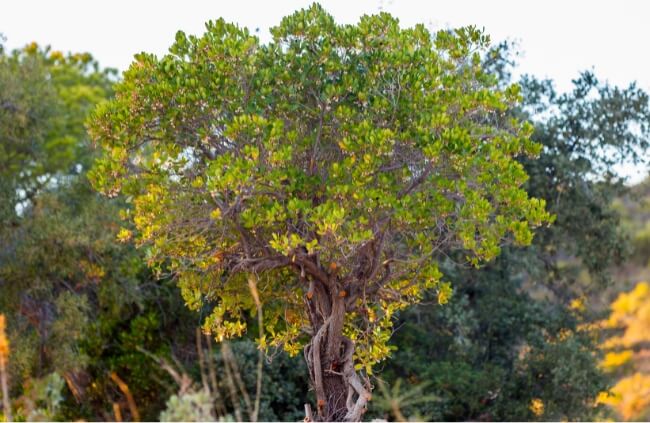
- Maximum size: Up to 6 metres high and a spread of 4.5 metres.
- Deciduous or evergreen: Evergreen
- Best features: The bark of the Irish Strawberry Tree starts off a deep red shade and becomes a dark brown as it gets older. It produces bright white flowers in abundance, especially during autumn and winter.
- Best place to plant: Your tree will need to be planted somewhere sunny with well-draining soil. It can also handle a spot with partial shade.
- Irish Strawberry Tree Growing Guide
Water Gum (Tristaniopsis laurina)

Source: Online Plants
- Maximum size: The tree can grow between 5 and 15 metres tall with a spread between 3 and 6 metres.
- Deciduous or evergreen: Evergreen
- Best features: Water Gum trees produce bright yellow flowers in summer and the tree also works well as a living privacy screen for your garden.
- Best place to plant: This tree does well in most soil types and can handle shade but does prefer the sun. It’s a good choice for a coastal garden as it’s salt and drought resistant.
- Tristaniopsis laurina Growing Guide
Magnolia Teddy Bear (Magnolia grandiflora)

- Maximum size: The tree is usually between 3 to 6 metres in height and 2 to 3 metres wide.
- Deciduous or evergreen: Evergreen
- Best features: The Magnolia Teddy Bear keeps a compact shape and makes a great hedge. It has big and round leaves with a green and glossy top side and a bronze colour underneath. It produces big white flowers from the end of spring to autumn.
- Best place to plant: This tree is versatile, working in a variety of garden sizes and can also be planted in a pot or to create shade. It prefers full sun, between 5 and 6 hours per day, but will also do fine in partial shade.
- Magnolia Teddy Bear Growing Guide
Jacaranda Tree (Jacaranda mimosifolia)
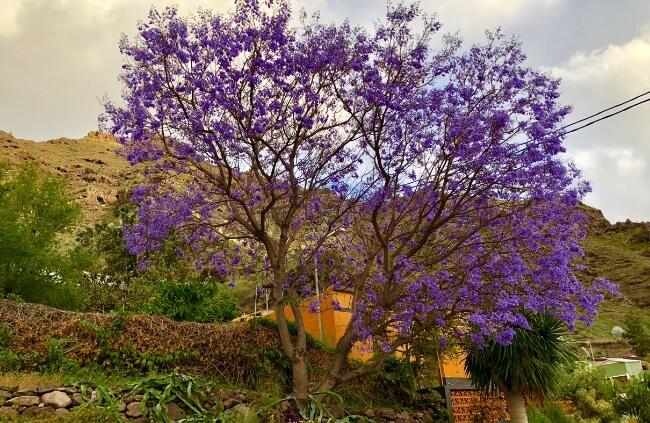
- Maximum size: The tree grows to a height between 8 and 15 metres and between 5 to 10 metres wide.
- Deciduous or evergreen: Deciduous
- Best features: The Jacaranda Tree produces violet colour flowers in big clusters and they are long lasting too, appearing in spring and at the beginning of summer. They create a lovely shade cover thanks to arched branches and leaves like ferns.
- Best place to plant: This tree will perform best in full sun, ideally between 6 and 8 hours each day.
- Jacaranda Tree Growing Guide
Golden Wattle (Acacia pycnantha)

- Maximum size: The tree can grow up to 8 metres tall and 6 metres wide.
- Deciduous or evergreen: Evergreen
- Best features: The Golden Wattle has flat leaf stalks instead of actual leaves. It creates golden flowers with a lovely fragrance from the end of winter into spring.
- Best place to plant: This tree needs soil that is well-draining and full sun for optimal growth.
- Golden Wattle Growing Guide
Plane Tree (Platanus orientalis)
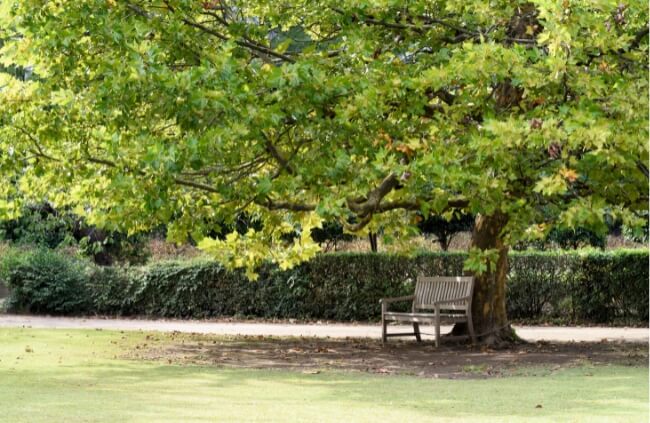
- Maximum size: Up to 30 meters in height and width.
- Deciduous or evergreen: Deciduous
- Best features: The Plane Tree has bark that is a colour combination of brown, gray, and cream. The leaves are big and look similar to a maple tree. It also produces balls of fruit all the way into winter. It would work well as a shade tree.
- Best place to plant: This tree grows best in full sun or partial shade. It also becomes drought tolerant once it’s reached maturity.
Finger Lime (Citrus australasica)

Source: Designer Trees Australia
- Maximum size: Between 2 and 7 metres tall and a width between 2 to 5 metres.
- Deciduous or evergreen: Evergreen
- Best features: The Finger Lime tree produces divine fruit which is often called caviar lime. The fruit is bright, has a tangy taste, and is packed with nutrients.
- Best place to plant: This tree needs dappled light constantly in order to create fruit. If you live in a colder region, you can aim for a spot that gets a few hours of full sun daily. For areas that are warmer, you can choose a spot with filtered shade. The roots need enough space to grow so don’t surround it with too many plants.
- Finger Lime Growing Guide
Dragon Tree (Dracaena draco)

- Maximum size: Up to 15 metres in height and width.
- Deciduous or evergreen: Evergreen
- Best features: The Dragon Tree has long leaves shaped like swords. They create texture for your garden landscape and also provide movement in the space. It produces white flowers with a powerful and sweet fragrance that permeates the air.
- Best place to plant: This tree can handle low levels of light. You could use it as a house plant or choose a spot that has bright and indirect light.
- Dracaena draco Growing Guide
Wrapping Up Our Best Feature Trees Guide
The best way to create interest and a visual focal point for your garden is using a feature tree. There is no ideal or right choice, and if you consider the main factors of purpose, size, and tree positioning, you can have fun choosing a tree that will enhance your garden for many years to come.
Published on October 22, 2023 by Maisie Blevins
Last Updated on September 19, 2025





It's like a roadmap to the green wonderland!? Who knew there were so many options to choose from? Mother Nature would be proud!? https://www.flowerpower.com.au/products/plants/trees seems like the ultimate destination for anyone ready to turn their garden into a symphony of trees. ?